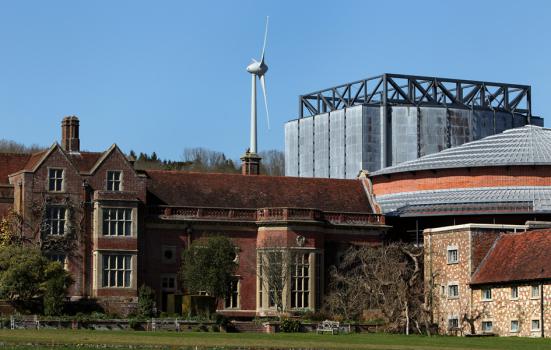Gus Christie tells the story of Glyndebourne's wind turbine, the first to be commissioned by an arts organisation.

Sam Stephenson
The evolution of our wind turbine began several years ago when I had a vision for a green future that saw Glyndebourne Productions Ltd eventually becoming carbon neutral. The installation of the 67-meter wind turbine was the first step towards us achieving this goal. After initial local opposition to the proposal, 2008 saw the then Secretary of State Hazel Blears grant permission for us to build the turbine. The development then took another three years’ planning and in December 2011 the turbine was commissioned.
The 2012 festival was the first to run on renewable energy, with the turbine ensuring that 89% of the power required to stage the operas was delivered sustainably via wind energy, very close to our aspiration of 90%. To date, the wind turbine is the single largest initiative undertaken to reduce both our carbon emissions and long-term expenditure on electricity.
The wind turbine provides us with the cleanest and most efficient natural energy with no fuel or waste-related costs. Furthermore, the investment is consistent with one of the company’s core objectives: to maintain financial independence by directly contributing to a significant reduction in annual electricity costs, in addition to generating income from the feed in tariff and through exporting surplus power to the national grid.
The wind turbine is the single largest initiative undertaken to reduce both our carbon emissions and long-term expenditure on electricity
We paid for the turbine entirely from working capital, a proposal that required careful consideration given that the total spend came in on budget at £1.5 million. Our finance director, Sarah Hopwood, confirmed that the proposal to install a turbine had to make financial as well as environmental sense, and the ‘feed in tariff’ subsidy was key to making the numbers add up. Sarah said: “We estimated the turbine would pay for itself within seven years on the basis that it would generate an average 90% of our annual electricity requirement. With 25 years’ planning consent we were confident that it was financially viable.”
Various financing options were considered, including a potential joint venture with a green energy utility company and setting up an enterprise investment scheme. These were thought impractical and the simplest and most cost-effective option was for us to independently fund the turbine.
The wind turbine is only one part of a long-term environmental strategy currently being implemented. As well as practical steps aimed at reducing carbon emissions and improving energy efficiency across the organisation, we have also committed to raising awareness of climate change with staff and audience members, artists, suppliers, supporters and partners. Current green initiatives include an on-site electric car charging point for staff and audiences, a free bus service for staff and visitors to and from Lewes station, a cycle-to-work scheme for staff, a comprehensive paper recycling scheme and cardboard bailing programme, and the gardening team runs a green waste scheme and composts 70% of all garden waste.
We have undertaken a broad range of environmental education activities since 2009. Most recently in 2011, the wind turbine inspired the youth opera production ‘On/Off’ which explored the idea of how we would cope with no electricity. ‘On/Off’ tracked the journey of young people with a heavy reliance on electricity, through a power cut and blackout to building a wind turbine and back to having electricity. The production was well-received and the highlight was the evidence that positive environmental actions can, and do, inspire creativity.
Gus Christie is Executive Chairman of Glyndebourne.
glyndebourne.com



